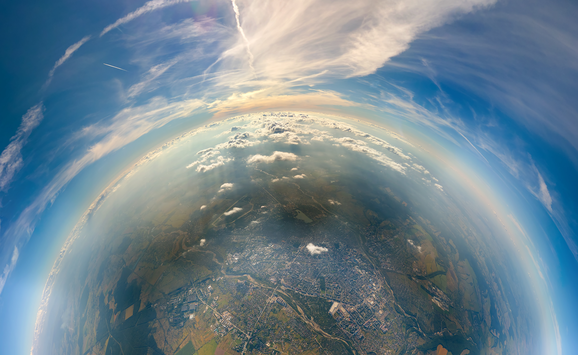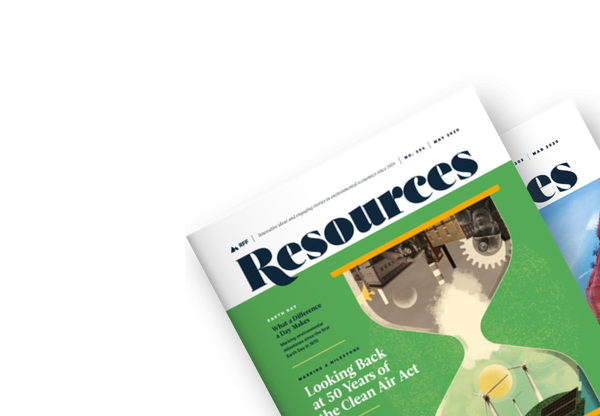In this week’s episode, host Kristin Hayes talks with Kaitlin Raimi about public perceptions of solar geoengineering. Raimi, a social psychologist and associate professor at the University of Michigan, describes how only around 15 or 25 percent of people know what solar geoengineering is, and those who are aware tend to be wary of the concept. She discusses techniques to inform the public about the benefits and pitfalls of solar engineering, avoid political polarization, and prevent solar geoengineering from being seen as the only solution needed to tackle climate change.
Listen to the Podcast
Notable quotes:
- Most people haven’t heard of solar geoengineering: “Well, I’d say the main finding is that the public doesn’t think about these activities. In studies that have actually reported percentages of people—that ask people whether they’ve ever heard of this before, and then report on those percentages—I mean, they’re all in the range of 15 to 25 percent of people saying they’ve ever heard of this.” (6:08)
- Whether or not solar geoengineering is seen as natural can affect public opinion on the emerging technology: “It turns out, not surprisingly then, that the naturalness is a major factor in how much people accept solar geoengineering or any other technology. The more that people see it as tampering with the natural world, the less they like it. One interesting thing that I found in my own work is that there’s also person-level differences in how comfortable people are with tampering activities.” (10:08)
- Correctly informing individuals about solar geoengineering is one of the most important ways to garner public support for the technology: “Solar geoengineering—because, again, 80 percent of people have never heard of it—is much more of a blank slate that people have less set opinions on … You have this opportunity as a communicator to get out ahead, set the tone, and give people correct information before they get false information.” (25:38)
Top of the Stack
- “Public Perceptions of Geoengineering” by Kaitlin T. Raimi
- “Solar Geoengineering” research at Resources for the Future
- Cane Toads: An Unnatural History documentary
The Full Transcript
Kristin Hayes: Hello, and welcome to Resources Radio, a weekly podcast from Resources for the Future (RFF). I’m your host, Kristin Hayes. My guest today is Kaitlin Raimi, a social psychologist and associate professor of public policy at the Gerald R. Ford School of Public Policy at the University of Michigan.
Kaitlin studies a range of issues at the intersection of belief, perception, communications, and behavior related to the environment. If the name sounds familiar, that’s because Kaitlin is married to my fellow Resources Radio host, Daniel Raimi.
I had the pleasure of interacting with Kaitlin earlier this year at a workshop on solar geoengineering, and that’s defined by the US Environmental Protection Agency (EPA) as “a set of activities intended to cool the earth by intentionally modifying the amount of sunlight reaching Earth’s surface.” So, I think it’s fair to say that anytime we’re talking about individuals or (particularly) governments intentionally modifying Earth systems, people will have questions and concerns.
Today, we’re going to be talking about Kaitlin’s work on the public perceptions of solar geoengineering—which, in my view, really lies at this fascinating intersection of science, trust, messaging, and a lot of things that really matter in our discourse these days. So, stay with us.
Hi, Kaitlin, and welcome to Resources Radio. I’m chuckling because you’ve probably heard many of these episode recordings taking place within your house, but I’m really pleased that we found an opportunity for you to join us as a guest.
Kaitlin Raimi: Well, thank you for having me. I’m a longtime listener.
Kristin Hayes: That’s great. I’m not sure what I would say if you told me this was your first time ever hearing Resources Radio—but no, it’s great to have you here.
Quickly, before we actually get into this complicated world of solar geoengineering, I’d love to just ask you a little bit about how a social psychologist ends up working on environmental issues at a public policy school. That’s quite a combination of things.
Kaitlin Raimi: The short answer is by accident, but I’ll give you the slightly longer version, which is that I am a psychologist to start. I was a psych major in undergrad, and really love social psychology—which is all about how people think about themselves in relation to others, how they think about their identities, how they pursue goals, and things like that. I was really fascinated with how people tick, but was trying to think about [how] I wanted to use it for some good.
I’m dating myself here, but right around the time I graduated college was when An Inconvenient Truth came out and lots more discussions of climate change. It seemed really clear to me that people are causing this problem, we will need people to fix this problem, and psychology actually might have some different answers (or different ways) of figuring that out.
I wanted to do a PhD. There weren’t, at the time (and still aren’t), really a lot of programs where you can really be a social psychologist looking at environmental issues. So, I went and got a straight-ahead social psychology PhD, and tried to pull in the environmental piece where I could.
Then, I ended up doing a postdoc, where I went from being the only person at a psych department who cared about the environment (or studied the environment) to being the only person in an energy and environment institute who had a psychology background.
I spent a lot of time having to … I was hired by someone who was a lawyer; I worked with hydrologists and physicists and sociologists. So, I got very good at talking across disciplinary lines.
The guy who hired me is named Mike Vandenbergh. He’s a lawyer who had worked at EPA, and he was really pushing me to do policy relevant work or look at policy-related questions. So, when I went up for the job market, [it] turned out that the Ford School at Michigan was looking for a cluster hire of people who studied sustainable behavior.
So I said, “Well, I’ve never thought about working at a policy school before,” even though I was (by that point) married to Daniel, who has an MPP [Master of Public Policy] degree. I always thought that was his domain, but I applied for this job, and I ended up getting it. It actually ended up being wonderful because it’s social science, but interdisciplinary. I can do what I do, and I don’t have to try and publish in the places that psych departments would want me to publish in. So, it was an accident, but it’s a happy one.
Kristin Hayes: That’s amazing. I think that really reaffirms something. I very briefly referenced this workshop that you and I both attended back earlier in the fall of this year, 2025. But, what’s great about this particular workshop (and I’m bragging on RFF’s behalf)—it is a social science workshop on these topics on solar radiation modification or solar geoengineering. What I love about it is that it’s not just the economics, which is RFF’s mainstay, but it does include psychologists, philosophers, and all of these really important disciplines that feed into behavior and the moral issues surrounding some of these questions.
I just think it’s great, because it’s so true. It’s so honest that there are all these different disciplines that come into play when you’re talking about these complicated questions. So, I love it. I love that’s how you ended up, and I’m glad it’s worked out so well.
Kaitlin Raimi: Yeah, thanks. And thanks for the workshop, it was great. It was a great mix of people.
Kristin Hayes: Oh, good. Well, let’s dive in here. You and I talked a little bit about how to dive into this topic, and we ended up focusing on a review article that you put together a few years back. So, it was in 2021, but it was a great place to start as a basis for this conversation, because it looks across a whole range of studies on perceptions of solar geoengineering.
Maybe I can start by asking you to just set a baseline. What are the most prevalent findings, to the extent [that] there’s consistency there, about what the public (and again, I’m going to use that term broadly speaking) thinks about these activities that are broadly characterized as solar geoengineering.
Kaitlin Raimi: Well, I’d say the main finding is that the public doesn’t think about these activities. In studies that have actually reported percentages of people—that ask people whether they’ve ever heard of this before, and then report on those percentages—I mean, they’re all in the range of 15 to 25 percent of people saying they’ve ever heard of this.
We know, from other research, that people tend to inflate reporting on what they know. People overclaim knowledge; they don’t tend to underclaim it. So, if anything, that’s probably at the high end of people who’ve actually ever heard of these things before. So, that’s the main thing to know—that 80-some percentage, of the public has never heard about these at all, or has really low familiarity with them.
Then in studies, like some of the ones I’ll talk about where people are given a little bit of an introduction to what solar geoengineering is, they are often wary of it. Compared to other technologies that are also new for a lot of people, like carbon removal or some new energy technologies, the support for solar geoengineering seems to be a little bit lower than those others. People are a little bit more wary of it.
But I also say—and this will be a caveat for anything we talk about when it comes to public perceptions of solar geoengineering—that this is a world where there’s no solar geo going on, yet. So, the public perceptions, what we find now in terms of what the public thinks about these technologies, may change a lot once people … If solar geoengineering ends up happening, people’s perceptions might change very quickly and be really focused on different aspects.
Right now, a lot of it is people’s abstract ideas of what it is. But, on the ground, how it might have concrete effects on people’s lives can shift opinion a lot.
Kristin Hayes: Fair. You’ve already mentioned the wariness, which is very unsurprising to me. That, even when you start to hear about it (when it’s described to you), there’s a certain sense of curiosity and, perhaps, discomfort.
I know you looked at a range of factors that could influence public perceptions, but certainly, one of the ones that you talked about was this question of naturalness: How natural of an intervention is this? So, I want to just read a little bit of what you said, because I think it captures it really well. You noted that a number of studies have highlighted the importance of perceived naturalness to public perception of geoengineering, but then you also note that whether any given approach to geoengineering is unnatural is both subjective and malleable.
I thought that was a really fascinating set of pairings back to back, so I interpreted this as people bring their own baseline feelings about tampering with nature.They bring those baseline feelings to this geoengineering conversation, but you can actually change some of those feelings based on different framings, or those can affect their perceptions. I’d love to know if I’ve got that right as a reductionist take on that, and then [I’m] really curious to see how and what researchers have been learning about that.
Kaitlin Raimi: Well, you did get it right, is the first answer. People just in general, not even related to geoengineering per se, but just everyone—people tend to have a strong preference for things that they think are natural. This is why, when you go to a grocery store, you see labels for natural things all over, because even though those labels are meaningless, people gravitate toward them. This shows up with food; it shows up with technologies of all kinds; it shows up with natural disasters. If they’re described as natural, people think that they’re less damaging than if they’re told that they’re human caused, even if it’s the exact same amount of damage.
Kristin Hayes: Oh, that’s interesting.
Kaitlin Raimi: People are weird.
Kristin Hayes: That’s going to be the title of this episode, by the way.
Kaitlin Raimi: That’s going to be the title. That’s the title of all of my work. “People Are Weird; Let’s Figure Out How.”
Kristin Hayes: People are weird; people are unpredictable.
Kaitlin Raimi: So, people are weird, and they are really into things that are natural. It turns out, not surprisingly then, that the naturalness is a major factor in how much people accept solar geoengineering or any other technology. The more that people see it as tampering with the natural world, the less they like it.
One interesting thing that I found in my own work is that there’s also person-level differences in how comfortable people are with tampering activities. Some people, just in general and regardless of the exact nature of the technology, are more comfortable with tampering with nature than others. It seems like it’s this combination of any person’s individual level of comfort with tampering with nature, and their perception that any technology tampers, that matters in terms of really strongly protecting acceptance of technology. So both my personal level, and how much I see this particular technology as tampering, matters.
But, like you said, this is malleable. Because people have never heard of these technologies before, the way they’re initially described really affects people’s perceptions of them. The same technologies are sometimes explicitly, or implied to be, more natural than others. This comes up with carbon removal even more when people talk about nature-based solutions.
But in solar geoengineering, there’s just ways of talking about it that seem more natural than others. So, for example, there’s one experiment that was done that used natural analogies to describe either carbon removal or solar geoengineering—so, talking about carbon removal as artificial trees to pull in carbon, and talking about solar geoengineering and describing it as acting like a volcano.
Though you might think of a volcano as something that’s very scary, it is natural. And having that naturalness in there seemed to make people both think that the technology is more natural, and make them like it more. Even though the technology itself hasn’t changed—it’s just the way you’re talking about it. It seemed to shift how natural people think it is, and so it’s movable.
Kristin Hayes: It’s interesting to me, too. The volcano example, I think, is a particularly intriguing one to me, because you’re right. It’s not that it’s comparing it to something nonthreatening, but it is comparing it to something both familiar and at least understandable, too.
Just thinking about my own reactions to that, that is actually a very … Even as someone who knows a little bit about the technologies, and why people are considering these technologies, it’s still useful to have that framing of like, “Yes, this is something that at least I can wrap my head around.” So, I’m imagining there’s some combination of both the natural and the familiar that matters in this, too. It’s interesting.
Kaitlin Raimi: Absolutely. There’s also some other evidence that suggests that those things might be really closely correlated—the familiarity and the naturalness—and that the more familiar something is, the more natural we tend to think it is, as well.
Kristin Hayes: Even if that’s not the case, I would guess.
Kaitlin Raimi: Yeah. I mean, it’s a little bit hard to pull these things apart, but yeah.
Kristin Hayes: So interesting. Kaitlin, I’m just going to tell you in another lifetime, I would be you. I think you have the coolest job.
Well, okay, let’s pivot and turn to another broad area that you talk about in the paper. I think this is something that comes up in all sorts of conversations around action to reduce emissions. It’s this idea that, if you even talk about solar geoengineering—something that would reduce sunlight entering the Earth’s atmosphere, and would cool the planet, essentially—in a way, that wouldn’t require some of the trade-offs of actually reducing greenhouse gas emissions, that people would actually choose that. That would crowd out public support for really doing the work of reducing emissions.
If you’re like, “Well, here’s this thing. We just shoot stuff up into the atmosphere, and it cools the earth, and we don’t have to change our economies and do all this hard stuff.” This is sometimes referred to as the moral hazard effect. So, I’m really curious: What have you seen in your work about the evidence related to what it tells us about moral hazard effects related to solar geoengineering?
Kaitlin Raimi: Yeah, so your point about how this is a really common thread across a range of different things made me laugh, because that is actually how I got into studying solar geoengineering in the first place.
During my postdoc, I did a lot of work on pro-environmental spillover. So if you get individuals to do one pro-environmental behavior, what does that mean for their likelihood of doing other pro-environmental behaviors? That often is framed in the same way: that we shouldn’t focus on individual efforts, because it’s going to crowd out support for big systemic policies. So, when I started hearing about geoengineering, it was a very similar conversation psychologically. I was really curious about whether the same things pop up here.
It’s a little different, because it is so unfamiliar. There are some differences, but a lot of it is the same. The big thing that’s the same is that the data is really mixed. There’s been, at this point, lots of studies that have been done that are experiments with the general public to see what happens.
If you give people some sort of information about geoengineering, does that then lead them to support emissions-reduction policies less than they would have without that geoengineering information? This is often called a moral hazard effect. I actually … The term I prefer is “risk compensation,” because I think it’s a little bit more precise about what’s going on.
The idea is that hearing about this technology, whatever it is, makes people feel like part of the risk of climate change is being reduced. So, that’s compensatory. You just need to fill your buckets in various ways. If some of that bucket is being filled by geoengineering, maybe you need less of it for emissions reductions.
That’s one possibility, but there’s also a possibility (a competing hypothesis) of risk salience—that if you talk about geoengineering with people, it makes them think, “Oh man, this must be a much bigger, scarier problem than I thought it was before. I’m going to be more worried about climate change, and more supportive of efforts to reduce it, so we don’t have to do this scary sounding thing.”
What the evidence suggests is that you find evidence for both. Actually, a lot of studies … Now, I’m the person everybody sends these papers to. I have to review, so I’ve seen a lot of them. Mostly, what you find are null effects. It’s really mostly null effects, or really small effects in either direction. One of my own studies suggests that this, again, may be due to framing.
We had one experiment where we had participants in one condition, and we told them that solar geoengineering was going to be a major solution to climate change—kind of a silver-bullet story. We had another condition where we told people that this was maybe going to solve part of the problem, or take care of part of the problems, with climate change, but it wouldn’t take care of everything.
People responded exactly as you would expect, and that if you told them this was a major solution, they said, “Oh, this is a major solution,” and they were less supportive of emissions-reduction policies after reading it. If they were told, “Maybe this will take care of part of the problem,” then that effect was not significant.
I think, again, this gets back to the fact that people have never heard about this, that the way you describe it really matters, and people are going to believe whatever they’re initially told. So, if it’s sold to them as a silver bullet, they’re going to treat it as one. But, if it’s not—if it’s talked about, correctly, as something that cannot take care of the whole problem—then they don’t seem to react as if it were a silver bullet.
Kristin Hayes: Interesting. I want to come back to that question of care, because I think that’s something that you emphasized in your paper a lot. At this time maybe not all framing—when there’s still a lot of unknowns, there’s still a lot of uncertainty in terms of actual deployment, and even about development—it’s just a very fraught time with figuring out how to communicate about this. Maybe we can come back to that question of, How do you really take care in your framings and messagings right now?
But, before that, I did want to ask you about one other lens on this that you look at in the paper—because, man, at least here in the United States, it really feels sometimes to me like public perception on just about any issue is getting filtered at the moment through this lens of political identity.
I know that’s something else that you looked at. Back in 2021, you noted that perceptions around geoengineering didn’t actually really neatly match or perfectly correlate with an individual’s other perceptions of climate change. So, I’m curious if that’s still the case. Can you just say a little bit more about that?
Kaitlin Raimi: Yeah. Well, the answer is that, what I say today may be different than by the time this podcast goes out, because this seems to be the area of solar geoengineering that is just changing the most rapidly. So, it’s definitely not the same context as it was in 2021, at least here in the United States. I’d say five to 10 years ago, people would sometimes talk about solar geoengineering as an approach to climate change that might be more amenable to political conservatives, because it wasn’t, at least on the surface, talking about technology. It wasn’t talking about a big government intervention in the way a carbon price or regulating emissions is, just on the surface. You can’t imagine a world where government’s not involved in that.
I actually didn’t see a lot of evidence of that in my own research. I tended to see that there wasn’t big political differences between the two. If anything, liberals seemed to support solar geoengineering a bit more than conservatives, but it didn’t make a big difference either way. So, that’s very unlike climate change, where we would always see this massive political polarization when we looked at a belief in climate change or support for policies.
But, in the last year or so, there’s just been this really big uptick in the number of bans on solar geoengineering in the United States at the state level, and now calls to ban it at the federal level. What’s really interesting about that is that most of these bans are being proposed by Republican representatives, if not all of them. Many of them seem to be tied to some conspiracy theories that conflate solar geoengineering with weather modification, and specifically fears that the government is causing hurricanes through solar geoengineering.
This is moving quickly. Who knows what direction it’ll take next, but I would expect that, as political elites start staking out geoengineering as a political battle, the public perception will follow. I think what I wrote about this not being really politicized back in 2021—I don’t think that is a quote that’s going to survive for super long.
Kristin Hayes: Fair enough. I mean, as noted, I feel like (at least here in the United States; I won’t speak for the rest of the world) it does feel like most things get filtered through that to some degree. So, I’m not surprised to hear that that’s evolving in this area, as well.
Maybe this is a good moment to actually ask you, and this is referencing back to what both of us heard at this workshop back in September: What was really interesting, in addition to the disciplinary diversity, there was also quite a bit of geographic diversity in the room. We got to hear from folks from lots of parts of the world who have also been looking at public-perception information, and conducting research in the places they live.
I would like to ask you to reflect on that for a minute, so anything that you’ve been focused on, about reflections on how geography plays into perception on this topic.
Kaitlin Raimi: Well, I want to commend you all for bringing in people from around the world for that, and also for RFF’s funding of research that I know funded some of this work. Super important to have a broad geographic range on this stuff. It’s so often that we overstudy the United States and Europe when it comes to anything including public perception.
From what I’ve seen of the studies that have looked at cross-country perception on geoengineering, there’s not a ton of them that have looked across multiple countries. Those that have seem to show a pattern where support for solar geoengineering seems to be higher in the Global South than it is in the Global North (generalizing).
The thought is that this might just be due to different perceptions of the risks of climate change—that people who are living in Global South countries feel like they are more at risk from climate change, and so are more willing to do just about anything that would help reduce that risk in the way that folks in the United States or elsewhere might not. That seems to be the general pattern.
I would say there’s still so much more of this work that needs to be done, that this is very early days, and I’m sure there’s a lot of nuance within that that we just aren’t quite capturing yet. But, that seems to be the initial reports that we’re getting.
Kristin Hayes: Interesting. I imagine that, also, as you pointed out earlier, could change really quickly if we start talking about deployment instead of something at least fairly notional now.
Kaitlin Raimi: Absolutely.
Kristin Hayes: So yeah, that’s really interesting to think about too.
Kaitlin Raimi: Just one other note on deployment. One thing that isn’t really a factor when people are thinking about abstract ideas of solar geoengineering, but absolutely will be a factor if it ends up happening, is attribution for weather events, flooding, droughts, or whatever. Because that attribution, as far as I understand it, is going to be near impossible, and that’s going to open up a lot of interpretation of any event as either being something caused by climate change itself or geoengineering.
That could really shift … The public opinion could really go haywire as people start making attributions. Some people are going to be attributing it based on their politics or what their political elites are telling them, and others are just going to be trying to make sense of it based on what they’re seeing in front of their eyes. I think that’ll really make things interesting.
Kristin Hayes: It’s such a sensitive topic even in conversation, to be honest. I don’t think there are many arenas where people don’t try to tread gently, recognizing that there are all these potential pitfalls. Maybe I will use that as a chance to get back to this “care” question, if you don’t mind. Really, just—I guess I’ll ask you. If you had any broad advice at this point as someone who thinks a lot about messaging, framing, and the care required at this fragile moment on this topic, do you have any kind of advice for folks who would be communicating around this now?
Kaitlin Raimi: I’d say the big thing is just to keep in mind … I think a lot of people who would be in the role of trying to communicate about solar geoengineering have experienced trying to communicate about climate change itself. I think it’s really important to keep in mind how different these are in the public perceptions.
When it comes to climate change at this point, everybody’s heard of it. Everybody has opinions about it. Everybody has evidence that they’re drawing on, and it’s really hard to change people’s perceptions, because they’ve really established them.
So, solar geoengineering—because, again, 80 percent of people have never heard of it—is much more of a blank slate that people have less set opinions on. That (in some ways) is an opportunity.
You have this opportunity as a communicator to get out ahead, set the tone, and give people correct information before they get false information. But, it also makes it risky if you’re going in there, and you’re the first person to tell people about it—more responsibility is on you. So, I think just thinking through carefully how you are describing this so that you’re, for example, carefully communicating that this is just not a substitute for emissions reductions (it would be an addition) is really important. Given the rising concerns that are tied to misperceptions about weather modification, just being really clear about how this is different than weather modification can be helpful.
There’s evidence. There’s some work on messaging inoculation that, if you tell people about misinformation that they might hear about in advance (give them advanced warning of the misinformation they might be getting) and debunk it (pre-bunk it before they get it), that helps them puts up their defenses before they get the disinformation. It’s much easier than going back after they’ve already heard it and trying to undo the damage. So, anything you can do at this point to just really clearly say, “This is what solar geoengineering is. This is what it’s not. Even if you might hear about this, it has nothing to do with chemtrails,” or whatever, I think might be an opportunity to do that now for much of the public.
But, also, just thinking through like … Again, I’m doing some work now on analogies, and thinking through analogies can be really helpful for helping people understand an unfamiliar topic. But, people draw inferences from those that may or may not be helpful, and so thinking through the logical implications of the analogies that you’re using and where people might go with that. I just think … For all of this, it requires, as you said, more care than we might think about for something that people have views on already.
Kristin Hayes: Well, that’s great. I know that there’s limited time in this world; there’s limited money in this world. All of these things that require those extra layers of care take both time and money. But, I just really appreciate the point that this is an important moment in this conversation. Just to really pay some extra attention to those messages and framings right now, I think, is really an important message, an important framing, for us all to take away with us.
Well, Kaitlin, this has been completely fascinating. I really appreciate your time talking about this. I know we’re about at the end of our time. I just want to close with our regular feature Top of the Stack. Again, I’m sure you know all about Top of the Stack, so let me turn it over to you. What’s on the top of your stack?
Kaitlin Raimi: I have been waiting to do this for years now! Top of my stack is a documentary from 1988 called Cane Toads: An Unnatural History. It is, as far as I can tell, not available on any of the major streaming sites, but I highly recommend requesting it from your local library or your university library. It’s absolutely worth renting a DVD player for.
It is this documentary that is about the explosion of cane toads in Australia. Backstory—cane toads were the species that were introduced to Australia in [an] attempt to eat these beetles that were eating the sugar cane. But it’s this classic story of people introducing some species that doesn’t have any natural predators, and then the introduced species just absolutely takes over and wreaks havoc. In this case, cane toads are also poisonous, which means they often kill prey and just add all kinds of fun elements to that.
But, the documentary itself is so surreal and weird, and they play all this music that people have written about cane toads. It really focuses on the people and the huge range of people’s reaction to cane toads. Everything from people trying to deliberately mow them over with their cars (and they make this really satisfying popping sound when they get run over) to children treating them like pets. There’s this little girl who dresses them up in doll clothes and pets [them], and then there’s people who would smoke the skins as a way to get high, because they’re poisonous. It’s all over the place. What I love about it is that it sums up my interest, as well.
On the surface, it’s about human interventions in the natural world and how that messes things up. But, in reality, it’s all about the many ways that people are bizarre, funny, and strange. I absolutely love it and can’t recommend it highly enough.
Kristin Hayes: Oh my gosh, that’s amazing. We do try to put links to our Tops of Stacks on the website, so I guarantee you that if we can find it out there on the internet someplace, we will put a link to it. Maybe it’s buried on YouTube somewhere, like those childhood Muppet videos that I’ve been looking for all along.
Well, that’s awesome. That’s a great recommendation, and that’s also a great way to tie together all the themes. So, thank you again. This has been really wonderful, and I will hopefully talk to you again soon.
Kaitlin Raimi: All right. Well, thank you so much for having me.
Kristin Hayes: You’ve been listening to Resources Radio, a podcast from Resources for the Future, or RFF. If you have a minute, we’d really appreciate you leaving us a rating or a comment on your podcast platform of choice. Also, feel free to send us your suggestions for future episodes.
This podcast is made possible with the generous financial support of our listeners. You can help us continue producing these kinds of discussions on the topics that you care about by making a donation to Resources for the Future online at rff.org/donate.
RFF is an independent nonprofit research institution in Washington, DC. Our mission is to improve environmental, energy, and natural resource decisions through impartial economic research and policy engagement. The views expressed on this podcast are solely those of the podcast guests and may differ from those of RFF experts, its officers, or its directors. RFF does not take positions on specific legislative proposals.
Resources Radio is produced by Elizabeth Wason, with music by RFF’s own Daniel Raimi. Join us next week for another episode.









